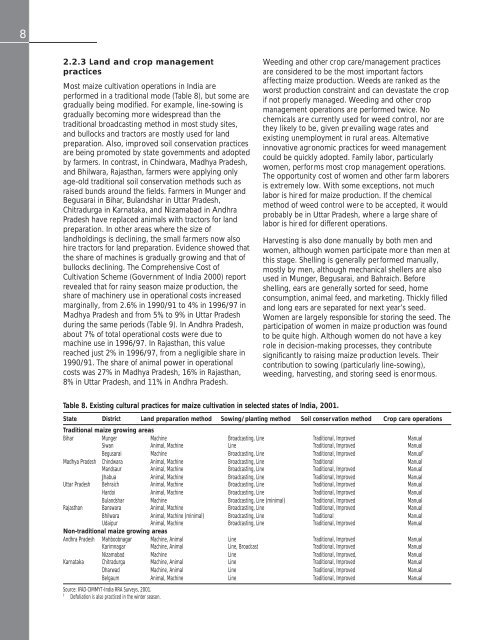Maize in India: Production Systems, Constraints - AgEcon Search
Maize in India: Production Systems, Constraints - AgEcon Search
Maize in India: Production Systems, Constraints - AgEcon Search
Create successful ePaper yourself
Turn your PDF publications into a flip-book with our unique Google optimized e-Paper software.
8<br />
2.2.3 Land and crop management<br />
practices<br />
Most maize cultivation operations <strong>in</strong> <strong>India</strong> are<br />
performed <strong>in</strong> a traditional mode (Table 8), but some are<br />
gradually be<strong>in</strong>g modified. For example, l<strong>in</strong>e-sow<strong>in</strong>g is<br />
gradually becom<strong>in</strong>g more widespread than the<br />
traditional broadcast<strong>in</strong>g method <strong>in</strong> most study sites,<br />
and bullocks and tractors are mostly used for land<br />
preparation. Also, improved soil conservation practices<br />
are be<strong>in</strong>g promoted by state governments and adopted<br />
by farmers. In contrast, <strong>in</strong> Ch<strong>in</strong>dwara, Madhya Pradesh,<br />
and Bhilwara, Rajasthan, farmers were apply<strong>in</strong>g only<br />
age-old traditional soil conservation methods such as<br />
raised bunds around the fields. Farmers <strong>in</strong> Munger and<br />
Begusarai <strong>in</strong> Bihar, Bulandshar <strong>in</strong> Uttar Pradesh,<br />
Chitradurga <strong>in</strong> Karnataka, and Nizamabad <strong>in</strong> Andhra<br />
Pradesh have replaced animals with tractors for land<br />
preparation. In other areas where the size of<br />
landhold<strong>in</strong>gs is decl<strong>in</strong><strong>in</strong>g, the small farmers now also<br />
hire tractors for land preparation. Evidence showed that<br />
the share of mach<strong>in</strong>es is gradually grow<strong>in</strong>g and that of<br />
bullocks decl<strong>in</strong><strong>in</strong>g. The Comprehensive Cost of<br />
Cultivation Scheme (Government of <strong>India</strong> 2000) report<br />
revealed that for ra<strong>in</strong>y season maize production, the<br />
share of mach<strong>in</strong>ery use <strong>in</strong> operational costs <strong>in</strong>creased<br />
marg<strong>in</strong>ally, from 2.6% <strong>in</strong> 1990/91 to 4% <strong>in</strong> 1996/97 <strong>in</strong><br />
Madhya Pradesh and from 5% to 9% <strong>in</strong> Uttar Pradesh<br />
dur<strong>in</strong>g the same periods (Table 9). In Andhra Pradesh,<br />
about 7% of total operational costs were due to<br />
mach<strong>in</strong>e use <strong>in</strong> 1996/97. In Rajasthan, this value<br />
reached just 2% <strong>in</strong> 1996/97, from a negligible share <strong>in</strong><br />
1990/91. The share of animal power <strong>in</strong> operational<br />
costs was 27% <strong>in</strong> Madhya Pradesh, 16% <strong>in</strong> Rajasthan,<br />
8% <strong>in</strong> Uttar Pradesh, and 11% <strong>in</strong> Andhra Pradesh.<br />
Weed<strong>in</strong>g and other crop care/management practices<br />
are considered to be the most important factors<br />
affect<strong>in</strong>g maize production. Weeds are ranked as the<br />
worst production constra<strong>in</strong>t and can devastate the crop<br />
if not properly managed. Weed<strong>in</strong>g and other crop<br />
management operations are performed twice. No<br />
chemicals are currently used for weed control, nor are<br />
they likely to be, given pr evail<strong>in</strong>g wage rates and<br />
exist<strong>in</strong>g unemployment <strong>in</strong> rural ar eas. Alternative<br />
<strong>in</strong>novative agronomic practices for weed management<br />
could be quickly adopted. Family labor, particularly<br />
women, performs most crop management operations.<br />
The opportunity cost of women and other farm laborers<br />
is extremely low. With some exceptions, not much<br />
labor is hired for maize production. If the chemical<br />
method of weed control were to be accepted, it would<br />
probably be <strong>in</strong> Uttar Pradesh, wher e a large share of<br />
labor is hired for different operations.<br />
Harvest<strong>in</strong>g is also done manually by both men and<br />
women, although women participate mor e than men at<br />
this stage. Shell<strong>in</strong>g is generally per formed manually,<br />
mostly by men, although mechanical shellers are also<br />
used <strong>in</strong> Munger, Begusarai, and Bahraich. Before<br />
shell<strong>in</strong>g, ears are generally sorted for seed, home<br />
consumption, animal feed, and market<strong>in</strong>g. Thickly filled<br />
and long ears are separated for next year’s seed.<br />
Women are largely responsible for stor<strong>in</strong>g the seed. The<br />
participation of women <strong>in</strong> maize pr oduction was found<br />
to be quite high. Although women do not have a key<br />
role <strong>in</strong> decision-mak<strong>in</strong>g processes, they contribute<br />
significantly to rais<strong>in</strong>g maize production levels. Their<br />
contribution to sow<strong>in</strong>g (particularly l<strong>in</strong>e-sow<strong>in</strong>g),<br />
weed<strong>in</strong>g, harvest<strong>in</strong>g, and stor<strong>in</strong>g seed is enormous.<br />
Table 8. Exist<strong>in</strong>g cultural practices for maize cultivation <strong>in</strong> selected states of <strong>India</strong>, 2001.<br />
State District Land preparation method Sow<strong>in</strong>g/plant<strong>in</strong>g method Soil conservation method Crop care operations<br />
Traditional maize grow<strong>in</strong>g areas<br />
Bihar Munger Mach<strong>in</strong>e Broadcast<strong>in</strong>g, L<strong>in</strong>e Traditional, Improved Manual<br />
Siwan Animal, Mach<strong>in</strong>e L<strong>in</strong>e Traditional, Improved Manual<br />
Begusarai Mach<strong>in</strong>e Broadcast<strong>in</strong>g, L<strong>in</strong>e Traditional, Improved Manual †<br />
Madhya Pradesh Ch<strong>in</strong>dwara Animal, Mach<strong>in</strong>e Broadcast<strong>in</strong>g, L<strong>in</strong>e Traditional Manual<br />
Mandsaur Animal, Mach<strong>in</strong>e Broadcast<strong>in</strong>g, L<strong>in</strong>e Traditional, Improved Manual<br />
Jhabua Animal, Mach<strong>in</strong>e Broadcast<strong>in</strong>g, L<strong>in</strong>e Traditional, Improved Manual<br />
Uttar Pradesh Behraich Animal, Mach<strong>in</strong>e Broadcast<strong>in</strong>g, L<strong>in</strong>e Traditional, Improved Manual<br />
Hardoi Animal, Mach<strong>in</strong>e Broadcast<strong>in</strong>g, L<strong>in</strong>e Traditional, Improved Manual<br />
Bulandshar Mach<strong>in</strong>e Broadcast<strong>in</strong>g, L<strong>in</strong>e (m<strong>in</strong>imal) Traditional, Improved Manual<br />
Rajasthan Banswara Animal, Mach<strong>in</strong>e Broadcast<strong>in</strong>g, L<strong>in</strong>e Traditional, Improved Manual<br />
Bhilwara Animal, Mach<strong>in</strong>e (m<strong>in</strong>imal) Broadcast<strong>in</strong>g, L<strong>in</strong>e Traditional Manual<br />
Udaipur Animal, Mach<strong>in</strong>e Broadcast<strong>in</strong>g, L<strong>in</strong>e Traditional, Improved Manual<br />
Non-traditional maize grow<strong>in</strong>g areas<br />
Andhra Pradesh Mahboobnagar Mach<strong>in</strong>e, Animal L<strong>in</strong>e Traditional, Improved Manual<br />
Karimnagar Mach<strong>in</strong>e, Animal L<strong>in</strong>e, Broadcast Traditional, Improved Manual<br />
Nizamabad Mach<strong>in</strong>e L<strong>in</strong>e Traditional, Improved, Manual<br />
Karnataka Chitradurga Mach<strong>in</strong>e, Animal L<strong>in</strong>e Traditional, Improved Manual<br />
Dharwad Mach<strong>in</strong>e, Animal L<strong>in</strong>e Traditional, Improved Manual<br />
Belgaum Animal, Mach<strong>in</strong>e L<strong>in</strong>e Traditional, Improved Manual<br />
Source: IFAD-CIMMYT-<strong>India</strong> RRA Surveys, 2001.<br />
†<br />
Defoliation is also practiced <strong>in</strong> the w<strong>in</strong>ter season.

















